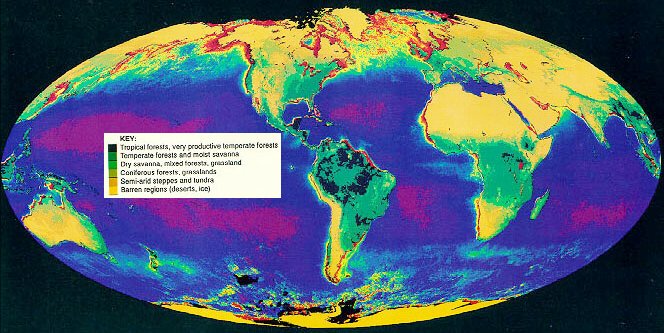Deserts make up about 1/3 of the land surface of the earth
Gobi Desert in Mongolia is a cold desert - temperatures range from 50C to -40C (122 - -40 F)
Bactrian camels (about 800 left) eat snow and ice; desert is result of rainshadow effect of the Himalayas
Sahara is largest desert being nearly as large as the United States - temperature
may drop 30 C (86 F) at night
Namib desert in Namibia has the largest dunes
Elephants in Namib may walk up to 50 miles/day for food; lions have smaller prides and larger ranges
Australia is the most arid continent with about 1/3 of the continent being desert; temperatures
may reach 70 C (156 F) during the heat of the day and kangeroos must use their saliva to cool their bodies
The Atacama desert in Chile is a cold desert and may be the dryest since it may not receive rain for 50 years
The Sonoran desert in Arizona has cacti which can store up to 5 tons of water in their trunks
Death Valley is the hottest desert; swarms of desert locust may extend up to 40 miles in width
Grassland or Plains - one fourth of the land is covered by grasses and these support the largest herds on earth
In Asia the grasslands are called the steppes, in South America the pampas and in North America the prairies in each case animals are exposed to the elements causing changes in nesting habitsd, e.g. eagles nest on the ground
grasses have a growth center (basal meristem) that is located at the bottom of the stem (not the tip) which provides some protection from grazing animals and fires
grasses cover more land than any other plant and feed more wildlife
polar grassland are known as the tundra zone; the Artic tundra is near 60 degrees north latitude near the north pole and Alpine tundra is found at the tops of high mountains; the Artic tundra is the size of the continent of Australia;
5 million snow geese migrate to the tundra a distance of about 3000 miles; grasses grow only a few months in these regions
the prairies of North America are similar to the veldt in South Africa; in the eastern section of North America the prairies consist of long stem grasses and flowers and grasses become shorter species as you move westward; this area in the west is sometimes known as the plains; the highest great plains is found in Tibet and its cold, thin, dry air support wild yak; the Himalayas are key to Tibet's dry area and to India's wet areas;
elephant grass is the tallest in the world; some African grass species are adapted to being submerged for part of the time; baboons are permanent year-round residents of the African and Indian plains
Trees are amongst the largest organisms on earth; one third of all the trees encircle the globe south of the poles; these coniferous forests are known as taigas and contain species that can survive the cold and short growing season;along the Pacific coast of North America exist the giant redwoods with a six month growing season; these giants can live for thousands of years and grow 10X faster than the trees in the taiga; the giant Sequoia Genral Sherman is the largest tree and is calculated to weigh as much as 10 whales; Bristlecone pines are the oldest and live more than 5000 years; organisms in the southern hemisphere are as varied as those in the north and include parakeets;
in the temperate zones are found the Temperate Deciduous forests which have broad edible leaves that are lost during the fall of the year and resprout in the spring; the spring brings the flowers and ferns as the trees begin to releaf; in the tropics the days and nights are of equal length but there are some trees that are deciduous
The video on the Oceans will not be tested due to administrative problems.

